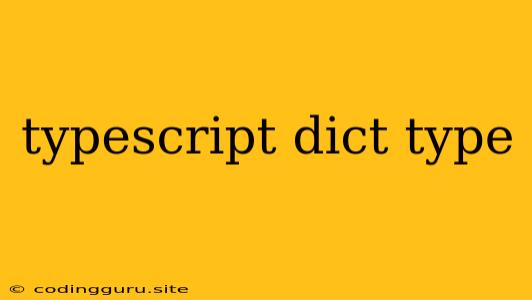Demystifying the TypeScript Dictionary Type: A Comprehensive Guide
TypeScript, a superset of JavaScript, empowers us to write more robust and maintainable code. One of its key features is the ability to define types, which provide structure and clarity to our applications. Among these types, dictionaries play a crucial role in representing data structures where keys and values are associated. But how do we effectively leverage dictionaries in TypeScript? This article delves into the intricacies of the TypeScript dictionary type, providing a comprehensive guide for beginners and seasoned developers alike.
What is a Dictionary in TypeScript?
In essence, a TypeScript dictionary is a data structure similar to JavaScript objects. It allows us to store key-value pairs, with each key uniquely identifying a corresponding value. This concept is essential for creating flexible and dynamic data structures, making it a versatile tool for various programming tasks.
Defining a Dictionary Type
TypeScript offers two primary ways to define dictionary types:
1. Using Indexed Access Types:
type UserDictionary = {
[key: string]: {
name: string;
age: number;
};
};
In this example, we define a type UserDictionary using indexed access types. It specifies that UserDictionary is a dictionary where keys are strings and values are objects with properties name (string) and age (number).
2. Using Generic Types:
type UserDictionary = {
[key: string]: T;
};
type User = {
name: string;
age: number;
};
const userDictionary: UserDictionary = {
'user1': { name: 'Alice', age: 30 },
'user2': { name: 'Bob', age: 25 },
};
Here, we define a generic type UserDictionary<T> where T is a placeholder for any type. This allows for greater flexibility by enabling us to define dictionaries for various value types. In this example, we use the User type as the value type, creating a dictionary of users.
Why Use Dictionaries?
Dictionaries provide numerous advantages in TypeScript:
- Flexibility: They allow you to store various data types, making them adaptable to different scenarios.
- Organization: They effectively organize data by associating keys with values, enhancing code readability and maintainability.
- Dynamic Access: You can access values based on their associated keys, providing dynamic data retrieval.
- Efficient Lookup: Searching for specific values within a dictionary is often faster than iterating through arrays.
Practical Applications of Dictionaries
Dictionaries are widely used in various scenarios, including:
- Configuration Management: Storing application settings as key-value pairs.
- Caching: Efficiently storing frequently accessed data in memory.
- Mapping: Translating values between different formats, such as converting string keys to numerical IDs.
- Data Structures: Representing relationships between entities, such as in graphs and trees.
Tips for Using Dictionaries Effectively
- Choose Meaningful Keys: Use descriptive keys to improve code clarity and understanding.
- Validate Input: Ensure that keys and values conform to the specified types to prevent runtime errors.
- Consider Data Structures: If your data has a specific order, consider using arrays or other appropriate data structures.
- Utilize Libraries: Explore libraries like TypeScript-Collections for more advanced dictionary operations.
Conclusion
Mastering TypeScript dictionary types unlocks a world of possibilities, enabling you to write more expressive and efficient code. By understanding their definition, advantages, and applications, you can effectively leverage these powerful data structures to build robust and maintainable applications.
